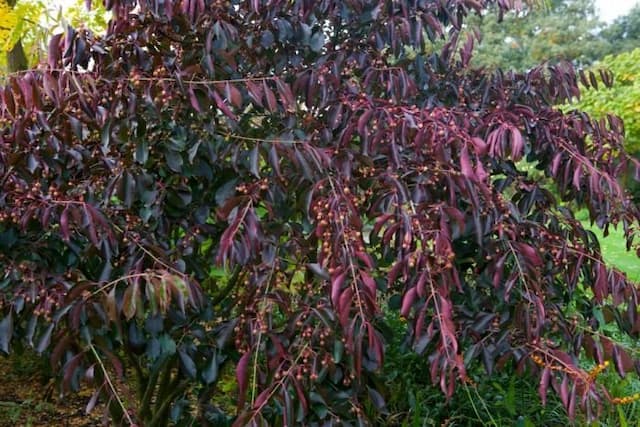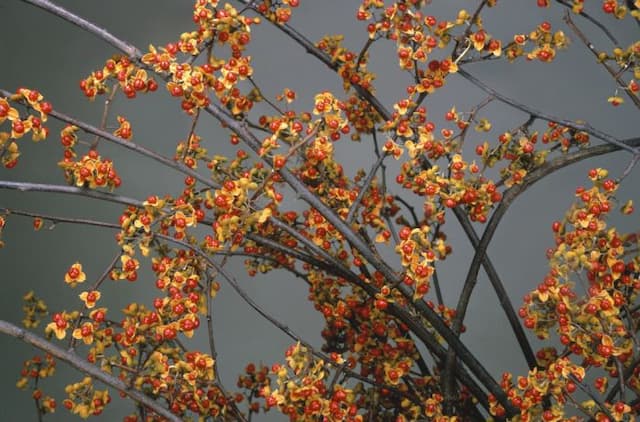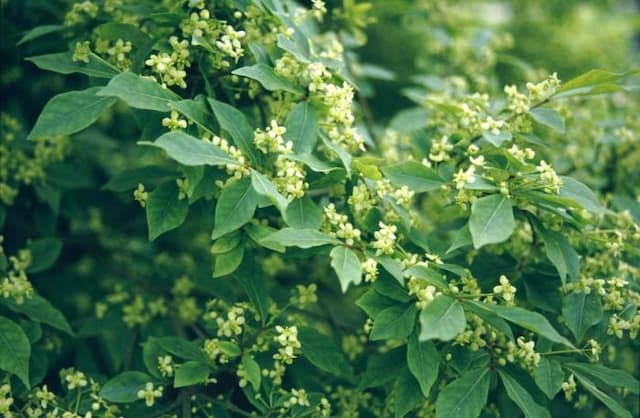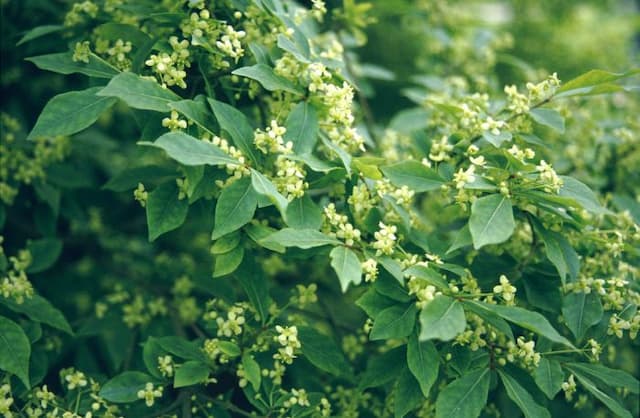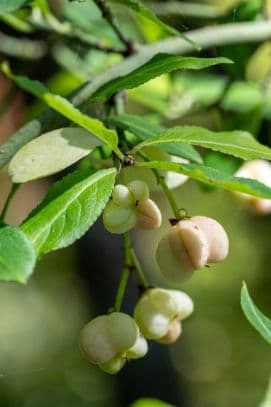Spindle 'Chollipo' Euonymus japonicus 'Chollipo' (v)

ABOUT
'Chollipo' is a bushy evergreen shrub with rounded rich green leaves broadly-margined with cream; seldom produces flowers and fruits
About this plant
 Names
NamesFamily
Celastraceae
Synonyms
Japanese Spindle, Evergreen Spindle, Japanese Euonymus
Common names
Euonymus japonicus 'Chollipo'.
 Characteristics
CharacteristicsLife cycle
Perennials
Foliage type
Evergreen
Color of leaves
Green
Height
6 feet (1.83 meters)
Spread
4 feet (1.22 meters)
Plant type
Shrub
Hardiness zones
6-9
Native area
Japan Korea China
Benefits
 General Benefits
General Benefits- Ornamental Appeal: Adds aesthetic value to gardens with its variegated evergreen foliage and compact, upright growth habit.
- Low Maintenance: Requires minimal care once established, making it suitable for busy gardeners or those looking for low-effort landscaping options.
- Drought Tolerance: Once established, tolerates periods of drought, reducing the need for frequent watering.
- Pest Resistance: Generally resistant to common pests, decreasing the need for chemical treatments.
- Versatility: Suitable for a variety of landscape uses, including hedges, borders, and foundation plantings.
- Adaptability: Adapts well to different soil types and pH levels, ensuring robust growth in a range of garden conditions.
 Medical Properties
Medical PropertiesThis plant is not used for medical purposes.
 Air-purifying Qualities
Air-purifying QualitiesThis plant is not specifically known for air purifying qualities.
 Other Uses
Other Uses- Japanese Spindle can be used to create a natural sunscreen by extracting compounds from the leaves that absorb ultraviolet light.
- The dense foliage of Japanese Spindle can be used as a sound barrier in urban gardens or along highways to reduce noise pollution.
- Woodworkers may utilize the hard, fine-grained wood of Japanese Spindle for making small, decorative items such as jewelry boxes or picture frames.
- The crushed leaves and stems of Japanese Spindle can be used as a natural dye for fabrics, yielding shades of yellow or green depending on the mordant used.
- Japanese Spindle branches can be soaked and woven into baskets or other artisanal crafts due to their pliability when young.
- When dried and pulverized, the leaves of Japanese Spindle can serve as a natural pest repellent in gardens to deter insects without chemicals.
- In floral arrangements, Japanese Spindle can provide sturdy greenery that complements flowers and maintains its form for an extended period.
- Japanese Spindle's dense canopy can be trimmed into elaborate shapes for topiary art, creating living sculptures in formal gardens.
- Its fast-growing nature makes Japanese Spindle a suitable species for biomass production or as a renewable source for bioenergy projects.
- The plant can be used in phytoextraction to absorb and sequester heavy metals from contaminated soils, helping to improve soil quality over time.
Interesting Facts
 Feng Shui
Feng ShuiThe plant Japanese Spindle is not used in Feng Shui practice.
 Zodiac Sign Compitability
Zodiac Sign CompitabilityThe Japanese Spindle is not used in astrology practice.
 Plant Symbolism
Plant Symbolism- Endurance: Euonymus japonicus, commonly known as Japanese spindle, can withstand various environmental conditions, symbolizing the ability to endure challenges and maintain persistence.
- Longevity: This plant is known for its long lifespan and evergreen nature, representing lasting life and perpetual vigor.
- Protection: Historically, it has been planted near dwellings to provide protection, as it was believed to keep away negative energies and harmful spirits.
- Versatility: The adaptability of the Japanese spindle to different soils and climates is reflective of flexibility and the capability to thrive in diverse conditions.
- Good Fortune: In some cultures, the plant is associated with luck and prosperity, often planted with the hope of bringing good fortune to the homeowner.
 Water
WaterThe Japanese Spindle 'Chollipo' should be watered deeply and thoroughly, allowing the soil to dry out somewhat between waterings. It does not like to be waterlogged, so be sure not to overwater. As a general rule, provide about 1 gallon of water per week during the growing season but be prepared to adjust depending on rainfall and temperatures. During the winter months, reduce watering since the plant's water needs decrease. Monitor the soil moisture regularly and water when the top inch feels dry to the touch.
 Light
LightThe Japanese Spindle 'Chollipo' thrives best in full sun to partial shade conditions. It's ideal to place it in a location where it can receive at least 4 to 6 hours of sunlight daily. While the plant can tolerate shade, too little light can lead to less vigorous growth and sparse foliage.
 Temperature
TemperatureThe Japanese Spindle 'Chollipo' can withstand a range of temperature conditions and is hardy in USDA zones 6 through 9. Ideally, it prefers temperatures between 50°F and 80°F. It can survive dips in temperature down to about 0°F but needs protection from severe frosts.
 Pruning
PruningPruning the Japanese Spindle 'Chollipo' is essential to maintain its shape, encourage bushier growth, and remove any dead or diseased branches. The best time for pruning is in the late winter or early spring before new growth starts. Periodic light pruning or shaping can be done throughout the growing season as needed.
 Cleaning
CleaningAs needed
 Soil
SoilThe best soil mix for Japanese Spindle 'Chollipo' is well-draining soil amended with organic matter like compost or peat moss to retain some moisture yet avoid waterlogging. A soil pH between 6.0 to 8.0 is ideal for this plant, with a slightly alkaline range being preferable.
 Repotting
RepottingJapanese Spindle 'Chollipo' should be repotted every 2 to 3 years to ensure the plant has enough room to grow and to replenish the soil with nutrients. If it's grown in optimal conditions and becomes root-bound, you may need to repot more frequently.
 Humidity & Misting
Humidity & MistingJapanese Spindle 'Chollipo' prefers moderate humidity levels but is quite adaptable to a range of indoor environments. A level of 40-60% humidity is best for this plant, aligning with typical indoor conditions.
 Suitable locations
Suitable locationsIndoor
Provide bright, indirect light; water when soil is dry.
Outdoor
Plant in partial shade; shelter from extreme weather.
Hardiness zone
6-9 USDA
 Life cycle
Life cycleJapanese Spindle 'Chollipo' begins its life cycle when seeds are dispersed after the fruiting period and germinate, given suitable conditions of soil warmth and moisture. The seeds develop into small seedlings, which exhibit the plant's characteristic glossy green leaves with creamy white margins. As the seedlings grow, they enter a vegetative stage marked by rapid foliage expansion and development of woody stems, with this evergreen shrub maintaining its leaves year-round in warmer climates. Once mature, typically within a few years, the Japanese Spindle 'Chollipo' will start to produce small greenish-white flowers in late spring to early summer, which are often inconspicuous. Following the flowering stage, small pink to red fruits develop, which upon ripening release seeds to begin the cycle anew. Throughout its life, which can span many years, the shrub may be pruned to maintain shape and encourage bushier growth, and it may experience cycles of growth and dormancy annually, particularly in regions with seasonal climate changes.
 Propogation
PropogationPropogation time
Spring-Early Summer
The most popular method for propagating Euonymus japonicus 'Chollipo', commonly known as Japanese Spindle, is through semi-hardwood cuttings. This process generally takes place in mid to late summer. One would cut a 4 to 6 inch (10 to 15 cm) long section of stem with several leaves attached. The lower leaves are removed, and the cut end is often dipped in a rooting hormone powder to encourage root growth. The prepared cutting is then placed in a pot with a suitable well-draining planting medium, such as a mix of peat and perlite. To retain moisture and create a beneficial microclimate, the cutting can be covered with a plastic bag or placed in a propagator. It typically takes a few weeks for roots to establish, after which the new plant can be transplanted.
